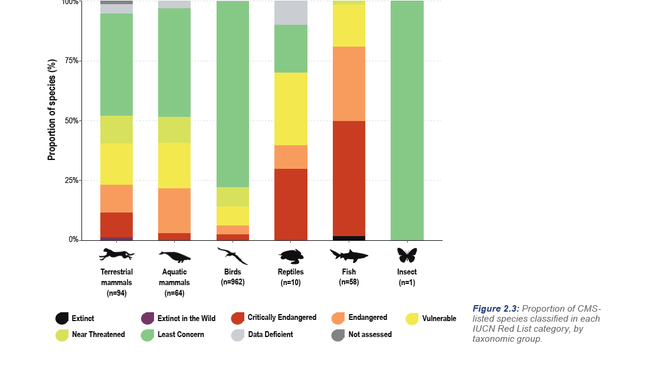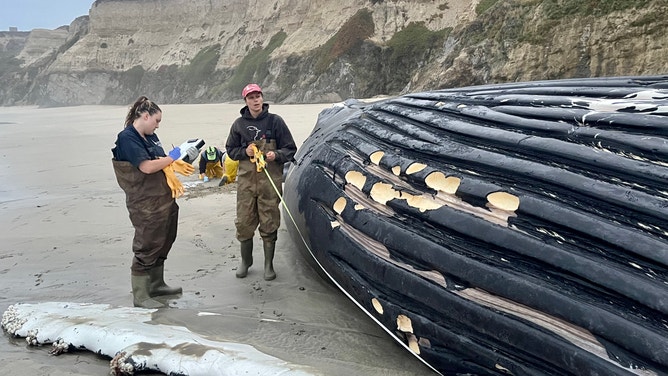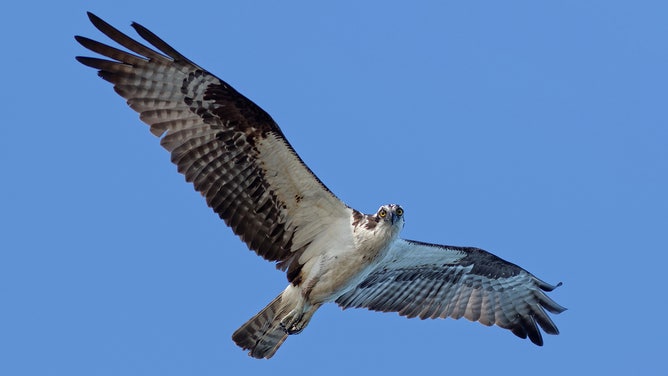1-in-5 migratory animals face extinction, first UN report of its kind says
The "State of the World's Migratory Species" report says humans and climate change are the primary reasons these animals are threatened, but offers ways governments and people can help protect them.
File: Australia's Christmas Island red crab migration underway
The annual migration of millions of red crabs from the rainforests of Australia’s Christmas Island to the coast is underway.
SAMARKAND, Uzbekistan – The first "State of the World's Migratory Species" report by the United Nations found that one in five migratory animals face extinction.
The report, which was presented at the Convention of the Conservation of Migratory Species' (CMS) Conference of the Parties on Monday, goes on to say that up to 97% of all migratory fish face extinction. Of all migratory species, 44% show population declines while another 22% are threatened by extinction despite their protected status. Of the CMS-identified sites critical to CMS-listed species, 49% have some policy protection while half are under "unsustainable" levels of human-caused pressure.
EMPEROR PENGUINS NOW LISTED AS THREATENED SPECIES

The graph shows the proportion of CMS-listed species classified in each Red List category, by taxonomic group.
(U.N. / FOX Weather)
"Migratory species are in trouble, and that puts humanity in trouble," Inger Andersen, executive director of the U.N. Environment Programme, warned at the Convention on Migratory Species.
"This is the first-ever comprehensive assessment of migratory species, and it shows how our behaviour – unsustainable human activities – are jeopardizing the future of these species, and by extension, the future of other species and humanity itself," Andersen added.
EASTERN MONARCH BUTTERFLY POPULATION SEES SECOND-LARGEST DECLINE ON RECORD
Reasons for extinction threat
The report points to overexploitation, degradation and fragmentation of the land, climate change, pollution (including light and noise) and the introduction of invasive species as the drivers of the extinction threat.
Overexploitation, the greatest threat for many animals according to the CMS Executive Secretary, is taking an animal from the wild intentionally. That can be hunting and fishing or accidentally catching the wrong species or bycatch, meaning undesirable animals that are discarded after being caught. Seven out of 10 of the listed species are affected by overexploitation.
Three out of every four species listed as endangered or critically endangered by CMS suffer from habitat loss, degradation and fragmentation.
21 ENDANGERED SPECIES DECLARED EXTINCT IN ‘WAKE-UP’ CALL TO CONSERVE THREATENED SPECIES. FEDS SAY
Why does humanity need migrating animals?
According to the report, migratory animals, which connect continents, countries, habitats and cross seas, provide a "variety of crucial functions" for humanity.
"The urgency for action to protect and conserve these species becomes even greater when we consider the integral but undervalued role they play in maintaining the complex ecosystems that support a healthy planet," said Andersen.
Some of the crucial functions listed in the report include:
- Nutrient cycling - Migratory species transfer energy and nutrients between marine, freshwater, and terrestrial ecosystems.
- Pollination and seed dispersal - Migratory birds, bats, and insects pollinate flowering plants and shape ecosystem structures by dispersing seeds.
- Ecosystem regulation - Migratory species provide food for other animals and can regulate ecosystems through predation and grazing.
- Climate change mitigation - Marine migratory species sequester carbon and help maintain habitats that are effective carbon sinks.
- Sustainable use and livelihoods - Migratory species can be an important source of food and ecotourism attractions can generate income for local communities.
- Cultural values - Migratory species provide aesthetic enjoyment, educational value and are spiritually significant.
WHY WE SHOULD THANK A BUG FOR DINNER: POLLINATION
"Migratory species rely on a variety of specific habitats at different times in their lifecycles," Andersen said. "They regularly travel, sometimes thousands of miles, to reach these places. They face enormous challenges and threats along the way, as well at their destinations where they breed or feed."
Extinction is not inevitable
The report points to 14 success stories, such as bird populations in Cypress that recovered after cracking down on illegal bird netting. The Saiga antelope of Kazakhstan made a turnaround thanks to conservation policies and restoration of their habitat.
Humpback whales are also making a comeback after reducing commercial whaling, bycatch and fish strikes.
"There are specific decisions and issues on the table at this very COP that could make a difference and must make a difference," Andersen said. "These include increasing ecological connectivity, tackling the illegal killings and taking of birds, reducing noise and chemical pollution in marine and other environments, and ensuring that we pay careful attention to commitments and obligations when we are considering potential deep-sea prospecting and mining."

File: Scientists performed a necropsy on this humpback whale in Half Moon Bay, California and determined it was killed by a ship-strike.
(Padraig Duignan and The Marine Mammal Center / FOX Weather)
Report offered as a cue to governments and individuals to make changes
The CMS identified habitats and offered action items to help the species at risk. The convention hopes for policy changes and enforcement across borders and nations.
"While some of them are aimed at governments and cities, for example, we can do a lot in the private sector, so can, any, any person who has a home and can learn how to reduce the impact of light pollution, which can include, of course, shutting off the light at night, but also even the type of light that they use or the way that they shine it, that already, would be, a very helpful measure," suggested CMS Executive Secretary Amy Fraenkel while speaking to U.N. News.
She also said that domestic cats are, in a way, an invasive species and are predators of native birds.

File: The osprey is a bird that bounced back. (Image: Audubon Florida)
(FOX Weather)
What does CMS-listed mean?
The CMS identified 1,189 species as critically endangered and endangered.
The report also details 400 other species not on the list but considered threatened and near threatened. These are largely birds and fish.
Different agencies have different endangered species lists. For example, the U.S. has its own protected species under the Endangered Species Act.


